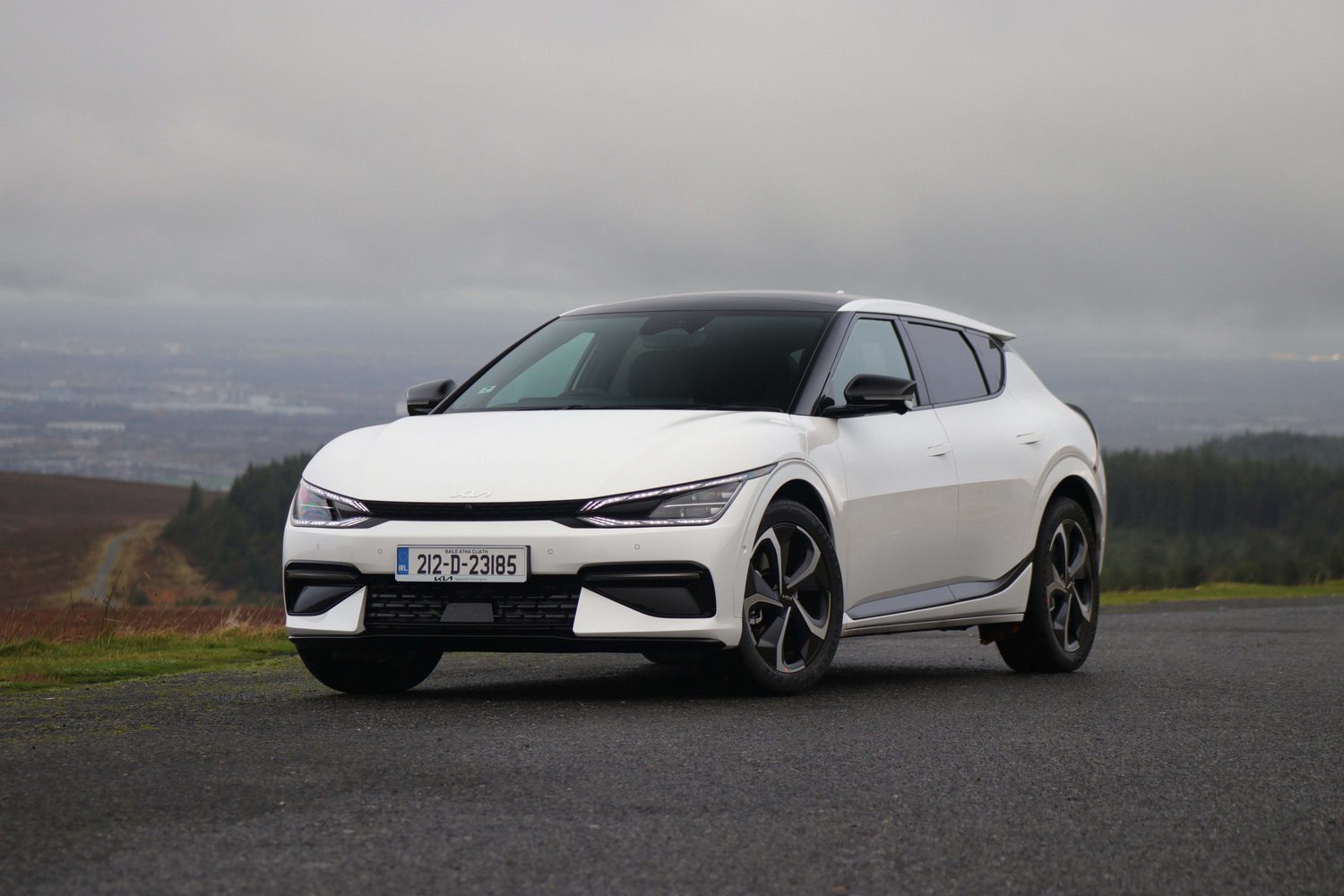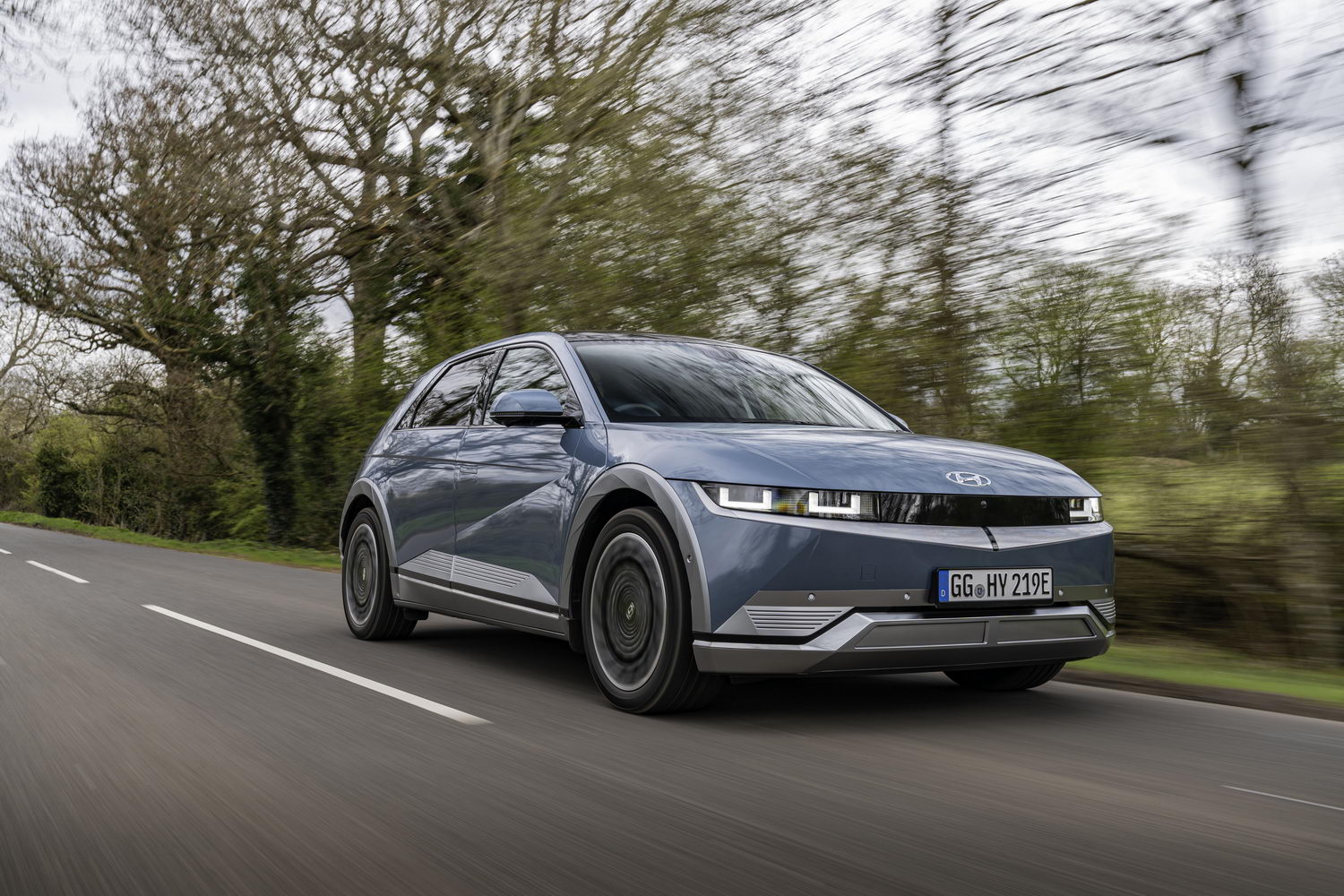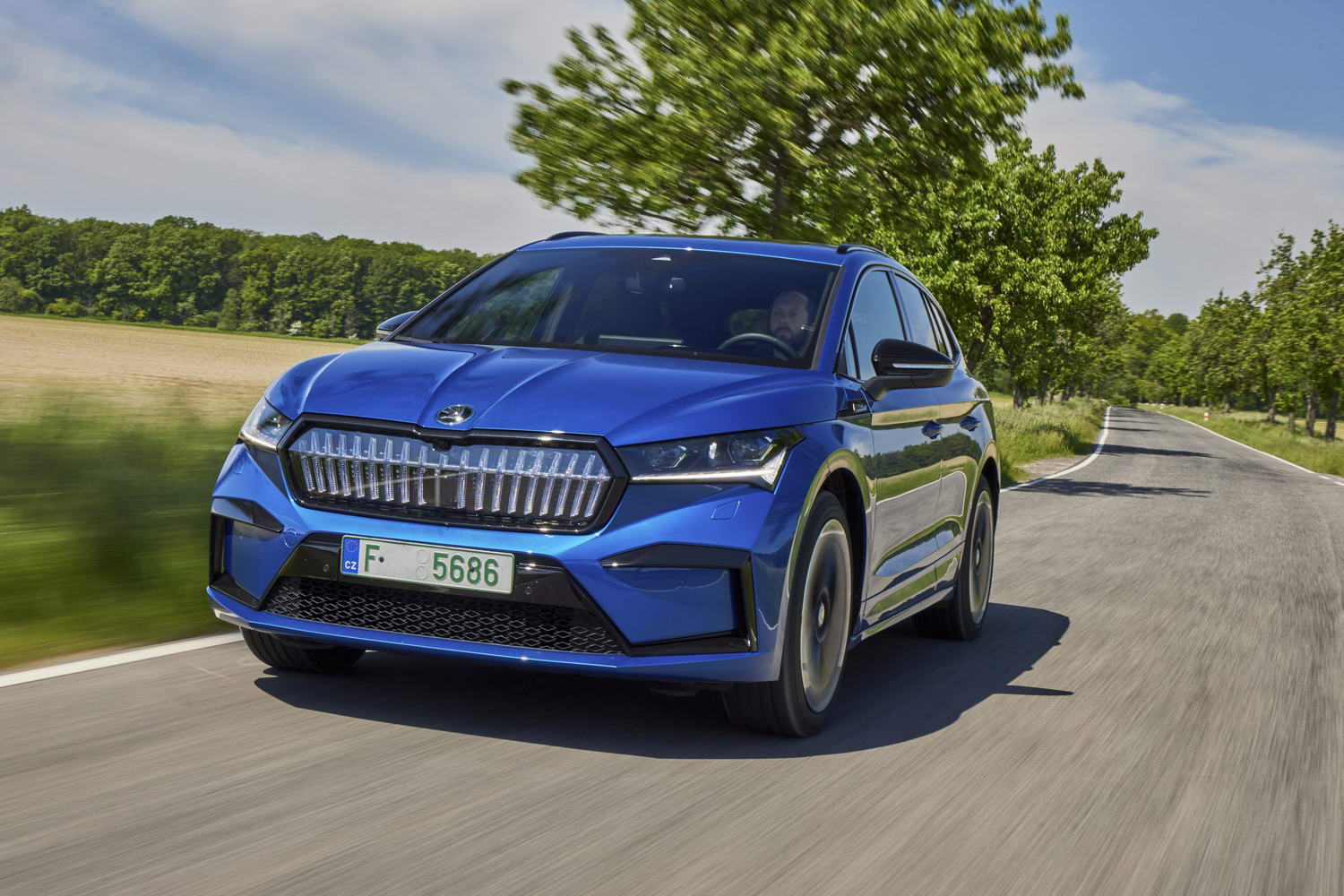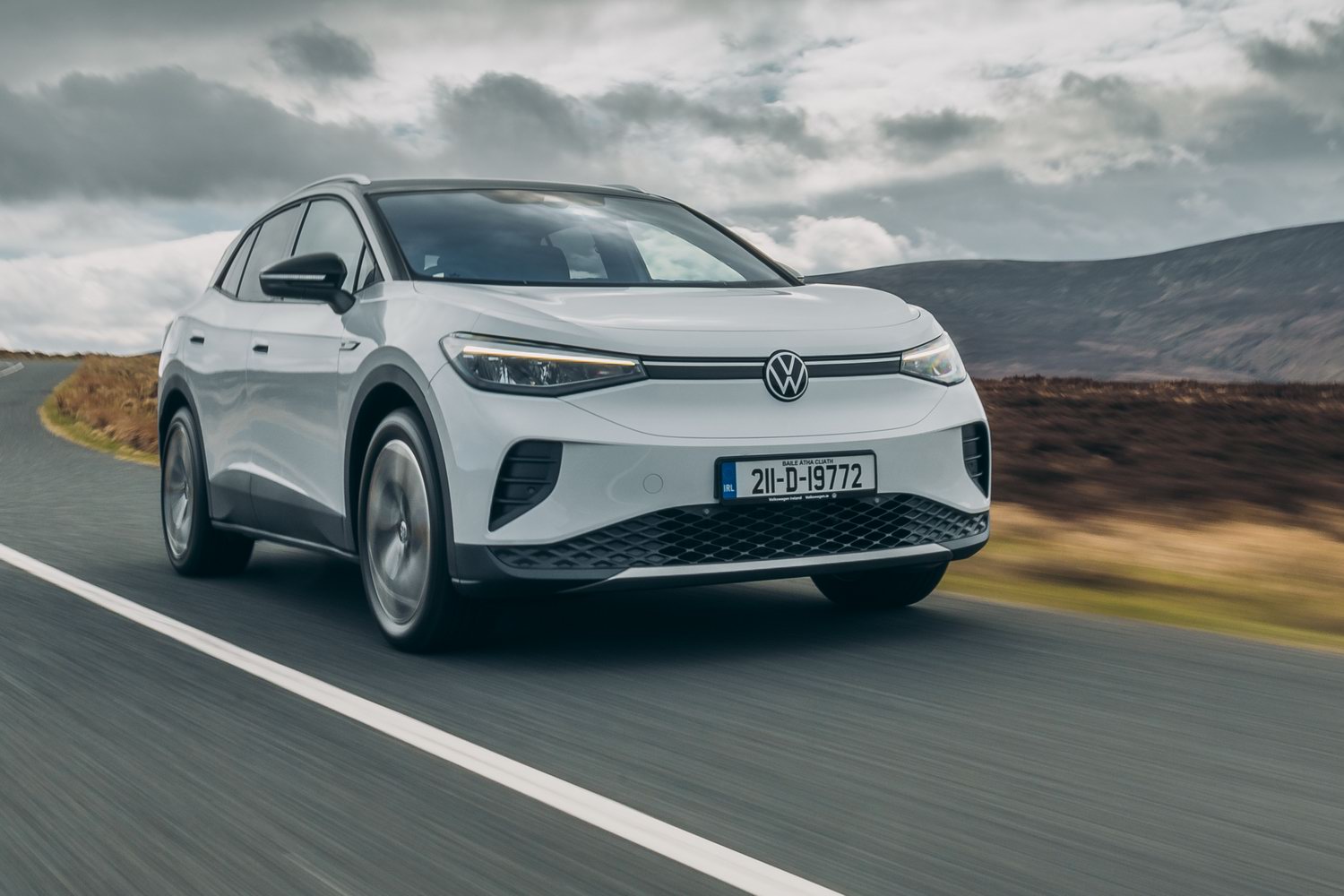Kia EV6 overview
Kia's EV6 is part of the latest two-pronged (so far...) assault by the Hyundai-Kia conglomerate on the world's electric car market. It's the sister car to the Hyundai Ioniq 5, and as such uses the same platform, the same battery packs and the same electric motors.
It does look hugely different to the Hyundai, though. The EV6 eschews the Ioniq 5's self-conscious retro touches in favour of a sleeker, more contemporary shovel-nosed look, with a daring kicked-up 'Kamm tail' at the back. The angled, visor-like glass shape is, according to the EV6's design team, a reference to the Lancia Stratos rally car of the 1970s. While the Hyundai is arguably more daring in its design, and the Kia a little more conventional, the EV6 is most definitely a very stylish car, striking in its proportions and to these eyes it's fractionally the better-looking of the two.
With the EV6, which sits in the Kia range well above the likes of the e-Niro and the e-Soul, Kia is taking on not merely the likes of Ford (with its Mustang Mach-E) and Volkswagen (with the ID.4), but is aiming right down the throat of Tesla, and even (in some ways) Porsche. We've seen impressive electric performance from Kia already, but can the EV6 live up to that kind of billing?
The Kia EV6 model range
There are just two models in the EV6 range so far, an entry-level model dubbed Earth, which costs €49,995; and the model we're assessing here, the GT-Line, which costs €54,344. Both use the same basic chassis and body, and the same 77.4kWh battery pack and single, rear-mounted 229hp electric motor.
Needless to say, both have zero emissions, and so qualify for the same €120 motor tax rate. The EV6 Earth has a maximum quoted range on a full charge of 528km, while the GT-Line manages 506km, mostly because it rides on 20-inch alloy wheels compared to the Earth's 19-inch rims.
Standard equipment on Earth models includes a dual 12.3-inch display screens, UVO connect live services, charcoal grey 'vegan' leather upholstery with premium relaxation seats, LED headlamps and a powered tailgate.
To that list, the GT-Line adds those 20-inch alloys, along with a GT-Line styling kit, suede-and-'vegan' leather seats (the front ones being ventilated), blind-spot view monitors, head-up display and panoramic sunroof.
To be honest, we're not sure the upgrade from Earth to GT-Line is worth the extra. Earth models are hugely well-equipped and have slightly nicer interior trim and, while items such as the head-up display and blind-spot monitors are useful, they're not deal-breakers.
Eventually, Kia will launch a much more powerful all-wheel-drive, twin-motor GT version of the EV6, which will accelerate to 100km/h in less than four seconds, but it's not yet known if Kia Ireland will market such a - presumably expensive - model here.
Kia currently has both hire purchase and PCP offers in place for the EV6, with monthly repayments starting from €518 on PCP, or €567 on HP, both plans having a 3.9 per cent APR interest rate. The car also comes with the offer of a €500 SuperValu gift card, but while Kia partnered with energy supplier Energia to offer buyers of the e-Niro, e-Soul and its plug-in hybrid line-up free home wallbox chargers, it hasn't yet added the EV6 to that list. Hopefully it will in due course.
To make sure you know the most up-to-date offers for the EV6, check out Kia Ireland's website.
The Kia EV6 interior
As with the Hyundai Ioniq 5, the Kia EV6's interior is one of its strongest points. Again, in style terms, it's a little more conservative than that of the Hyundai. The big screens atop the dashboard - both 12.3 inches across, one for instruments and the other for infotainment - are identical to that of the Hyundai, and some of the switchgear is carried over too, but the ambience is quite different.
While the Hyundai's cabin has a lighter, more open style to it, the Kia's is more traditional in its layout, with a high centre console and a more enclosed, snug feeling when you sit in. The front seats are actually set a little high, which means that at times you feel perched up and almost sitting in the roof, but they are extremely comfortable, and quite stylish with their avant-garde headrests. In our GT-Line test car, the seats come upholstered in an incredibly soft, plush synthetic suede, and are both heated and ventilated. The seat heating is especially volcanic, so welcome when chilly nights start drawing in...
Below the centre screen, there are air vents and a strip of trim that's backlit by LED lights. Beneath that, there's a touch-sensitive strip that manages both audio controls and the air conditioning system. Tap a button and the small rotary controls at each end of the strip switch from volume and track to controlling temperature. It's a neat setup, and simpler than having heating and air conditioning controls on the screen.
On the long centre console, at the forward tip, you'll find switches for the heated and ventilated seats and the heated steering wheel. Behind them is a large, round button for starting the car, and the rotary drive selector. Behind that are smaller buttons to toggle the parking sensors and cameras, and the auto-hold for the electronic parking brake.
Alongside those switches there are two large cupholders and a smaller oddments tray, plus a wireless phone charging pad. There's a larger, deeper storage box under the front seat armrest. Below the console, at the front, there's a huge storage tray, and in front of that are two USB sockets.
In the back, there's acres of space, although the EV6's rising window line means that the view out isn't as good as what you get in the taller Hyundai. The seats are comfortable, though, and the flat floor means that three adults can pretty comfortably sit side-by-side. There's a folding armrest in the centre, and the outer rear seats get USB sockets of their own, handily built into the front seatbacks. The door pockets in the rear are small though - they'll take a small 330ml bottle of water, but not much else.
The big screen in the centre of the dash manages the infotainment system, and it's a familiar layout if you've driven a recent Kia. Some of the menus are a bit deep and lengthy when you go looking for some items, but overall it's easy enough to use, graphically sharp and has lots of useful touches such as a navigation map that shows you an overlay of how far you can drive on your current level of charge. One thing, though - the screen is so big, and the EV6 so broad, that the left-hand edges of the screen are actually a bit of a stretch from the driver's seat.
The screen in front of the driver is crisp and clear, and you and use the steering wheel buttons to switch between various views including a trip computer, media display, navigation and more. It's not the best laid-out screen though - the speed readout is actually slightly obscured by the rim of the steering wheel depending on your driving position, and there's no option to move the display around. That's less of an option on the GT-Line, where you use can use the head-up display to monitor your speed, but the HUD is a tiny bit blurry and less sharp than that used by some rivals.
One thing we do love is the blind spot monitor - switch on the indicator, and into the instrument display pops up a wide-angle view down the side of the car, transmitted from a camera located under the door mirror. It's a handy little trick, and definitely a safety bonus.
Speaking of safety, the EV6 comes fully decked out with active cruise control that can handle stop-start traffic, lane keeping assistance (which tugs less frantically at the wheel than it does in the sister Hyundai) and rear cross traffic alert that warns you other cars are passing when you're trying to back out of a space. There's also an excellent 360-degree parking camera system, but the EV6 does lack such niceties as a digital rear-view mirror, which seems a shame given all the tech on show (and given that there's no rear wiper). Visibility is good out the front, thanks to a big windscreen and low nose, but much less so behind - the rising window line leaves copious blind spots, and that rear glass (again, with no rear wiper) is quite small and high-set.
The boot is decent, but not exceptional, at 528 litres up to the luggage cover, and seems a little shallow for the size of the EV6.
The Kia EV6 driving experience
Given that the EV6 and the Hyundai Ioniq 5 share a common platform, and given that - according to received wisdom - electric cars all feel broadly the same to drive, we can skip this section, right? If we've driven the Hyundai (and we have) then we already know what the Kia is like to drive.
Well, perhaps not. Actually, while there are certainly similarities, the EV6 drives quite differently to the Ioniq 5. The thing you'll notice most is that, even though the steering is quite light, and doesn't have much feel nor feedback, it does manage to feel more precise than that of the Hyundai. Consequently, even though the Kia is equally large, and especially wide, it feels easier to place on twisty roads, and easier too to thread through traffic. It is a fairly chunky car, the EV6 - 4,695mm long and 1,890mm wide not including the mirrors, but Kia's chassis engineers have made it feel much smaller, tauter and lighter than its two-tonne kerb weight.
Of course, much of that weight is in the batteries, and they are mounted down low, under the floor. That, combined with the fact that Kia has resisted turning the EV6 into yet another SUV (it's SUV-sized, but not SUV tall at just 1,550mm, and is really more of an oversized hatchback than anything else) means that there's much less lean in corners than you might expect, and you feel the gyroscopic effect of the weight much less when cornering and braking.
That braking includes regenerative braking, of course, and you can adjust the strength of that using what would normally be gearshift paddles behind the steering wheel, switching from freewheeling to strong 'one-pedal' driving.
The EV6 rides very well, too. It's slightly firm, mostly thanks to the 20-inch wheels, but never harsh, and always hushed. Actually, the whole car is impressively hushed with truly little wind noise nor tyre roar, even at motorway speeds. It's incredibly relaxing to drive, in fact.
That relaxation is helped by the long range on a full charge. Against an official 506km one-charge range, we managed a range of around 480km on a fully charged battery. The EV6 easily demolished our usual long motorway run from Dublin to Belfast without needing to stop. Indeed, it still had around a half-charged battery at the end of the journey. Overall electric consumption during our test worked out at 19kWh/100km, which is impressive given the size of the EV6, and the fact that we had the heat-pump heating system running a lot of the time to ward off November chills.
The Kia has some very clever battery tricks up its sleeve. A Porsche Taycan or Audi e-tron GT might cost twice as much, but the Kia has the same 800-volt charging system as them, which means that - when hooked up to one of IONITY's ultra-rapid 350kW charging points, you can charge from ten per cent battery to 80 per cent in a mere 18 minutes. It's quick to charge even on a slower 50kW charger too, and there's a 'vehicle-to-load' function, which means that you can plug other electrically-powered items (even other electric cars!) into the EV6 and charge them up. Eventually, you could potentially power your house from the EV6's battery.
Rivals to the Kia EV6
We've mentioned the Hyundai Ioniq 5 enough here not to need to bring it up again, but the Kia has some impressive rivals arrayed against it. Not least the Tesla Model 3 and Model Y. Against the Model Y, the Kia is similarly roomy, and has in and around the same range, but is much more affordable (and has better overall quality). The Model 3 is about as good value, and has longer range, but is a smaller car (it's sharper to drive, though). Ford's Mustang Mach-E is good to drive too, and hugely handsome, but it's not as practical, and can't match the Kia for value, even if the long-range version will go further still on a full battery. Skoda's hugely impressive Enyaq can be bought for much less cash, with a smaller battery, but costs about the same as the Kia once you spec it up with a bigger battery and some choice options. It won't charge as fast, nor does it look as striking, but on all-round performance the electric Skoda is probably the EV6's most serious opposition.
Our verdict on the Kia EV6
Kia has been over-performing in the electric car stakes for some time now - the e-Niro and e-Soul are exceptionally good electric cars, and just as good as newer opposition from the VW and Renault-Nissan Groups. The EV6, though, is a massive step forward. Yes, it's expensive for a Kia, but it rewards with an impressive driving experience, reliably long battery range, striking styling inside and out, comfort, quality, space and a general feeling that if all EVs could be this good, the transition to carbon-free motoring would be that much easier. And more pleasant. A genuine star car of 2021.


























